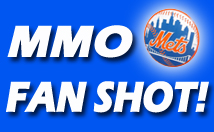
An MMO Fan Shot by Mr_O
It’s the middle of February, and the Mets still need a starting pitcher. In my previous MMO Fan Shot, I argued for the acquisition of Jakob Junis, a young back-of-the-rotation starter with the Kansas City Royals. Since that article was published on January 2nd, the Mets have acquired several players through trades and free agency, solidifying the bullpen and offensive lineup. Vexingly, the only addition to the rotation depth this winter was Walker Lockett, the Triple-A pitcher acquired for Kevin Plawecki, who will not be competing for a starting rotation slot this spring.
The Mets’ need for a starter to replace or compete with Jason Vargas is well-established. The specific player that will most benefit the Mets is dependent on our long-term payroll limitations – a persisting known unknown – and any potential trade demands, and luckily there are still options available. Trading for a starter at league minimum is feasible no matter those restrictions, but there still exists the possibility that our payroll allowance is lofty enough to permit an acquisition at a somewhat higher price point. In that case, there is another name we should be putting serious thought into.
Who is Zack Greinke?
Zack Greinke is a household name, at least among baseball fans. A 15-year veteran of the major leagues, he has pitched for five different major league teams, made 11 postseason appearances in five different years, and appeared in five All-Star games. His accolades include the last five consecutive NL gold glove awards, a silver slugger award in 2013, the AL Cy Young in 2009. He led MLB in ERA in 2009 and 2015.
In 2015, Greinke opted out of his $147 million contract with the Dodgers and signed a six-year, $206.5 million contract with Arizona. His contract with Arizona was just slightly backloaded, so Greinke will be making $34.5 million in 2019, $35 million in 2020, and $35 million in 2021 before the end of his contract. As of the writing of this article, he stands to be the highest paid player in baseball for each of those three years.

Now entering his age 35 season, Greinke has been a portrait of consistency over the bulk of his career. He has averaged 206.2 innings pitched per season since 2008, passing that mark in two of his last four seasons. After posting a down year his first season in the desert, registering only league average numbers, Zack rebounded to finish fourth in Cy Young voting in 2017. He followed that up with another stellar season in 2018.
However, Greinke is a very different pitcher than he was a decade ago. When he made his debut in 2004, he was a promising young flamethrower who regularly sat 95-96. By last season, he was sitting 90 in all of his starts.
The chart above shows his steady decline in velocity over the years (from 2007). When most starters see comparable declines in velocity, it tends to bode ill for their results. For some, there are exceptions. Despite now throwing softer than the vast majority of RHP in the game, Zack’s has continued to see extraordinary results. This even holds true when looking at his peripherals.

While Greinke’s velocity has waned, his strikeout rates, walk rates, and soft contact rates are all consistent with his fantastic career numbers, with no visible signs of decline. In addition, there are no notable anomalies in his career BABIP numbers, save for his 2015 campaign. Greinke has a reputation for being one of the most intelligent pitchers in the game, and the statistics appear to back that assertion up.
Even without the pure physical tools that other dominant pitchers have, Greinke has matched or bettered them year in and year out for nearly his entire career. In fact, his profile as a softer-tosser improves his potential outlook. He is less likely to be injured or see significant decline as he ages.
The only real knock on Greinke’s record is his missed season in 2006. As a 20-21 year-old Zack suffered from social anxiety issues that derailed his season. Personal issues of that nature are common among men of that age, and most often dissipate over time. They were not related to any particular venue, have not been a problem in the fifteen years since, and should not have any bearing on expectations for future performance.

Quid Pro Greinke
Arizona has been actively shopping Greinke this winter, as they look to retool or rebuild for the future. Dismayingly for them, his contract, age, and partial no-trade clause have proven to be considerable obstacles. According to Zach Buchanan in an article for The Athletic, Greinke’s NTC includes fifteen teams: the Yankees, Red Sox, Blue Jays, Orioles, Twins, Tigers, Angels, Athletics, Phillies, Cardinals, Reds, Giants, Rockies, Dodgers and Padres. The Mets are noticeably absent from that list.
Considering the context, Greinke bares more than passing resemblance to another recent trade target – Robinson Cano. Cano’s full no trade clause significantly limited the competition for his services, allowing the Mets to scoop him up with Edwin Diaz. Greinke’s clause only covers fifteen teams, but like Cano, it still blocks trades to most of the competitive teams who can afford to take him on. Also like Cano, any team that trades for Greinke would only be taking on a fraction of his remaining contract.
There are some differences between the two situations. First, the Mets would not be getting another Edwin Diaz in return with Greinke. Arizona simply does not have a comparable piece to offer, that we have a comparable need for. That removes Kelenic and Dunn equivalents from any package we offer. Second, Greinke is owed $104.5 million over three years, not five.
The lack of interest around the league this winter prompted reports that Arizona was content on waiting until the deadline to secure a better return, according to a December tweet from Bob Nightengale, but good business says Arizona would still prefer to deal him before the season starts.
Assuming that a team trading for Greinke would take on half of his contract, it would cost Arizona more than $11 million to wait until the July 31st deadline for a trade. That amount of money is almost sure to offset any potential improvement in their return, and then some. In other words, Arizona has strong incentive to trade him, and to trade him now.
Payroll Considerations
Before adding another contract to the payroll, we need to consider other priorities. Acquiring a high-caliber player would benefit the team, but long-term health of the organization still needs to be planned for. In the next three years, extending deGrom and Syndergaard would be the priorities over signing someone like Greinke. Thankfully, a deal like this offers some flexibility when dealing with payroll.

Using estimations from Cot’s, we can get a rough idea on how best to structure a deal. This table includes arbitration estimates based on current arbitration-eligible players, increases in payroll due to historical salary inflation rates, and makes three main assumptions:
- DeGrom is extended through the 2020 and 2021 seasons (at least) at a $25 million AAV;
- Syndergaard makes $12.5 million in arbitration in 2020, and is offered an extension at a $27.5 million AAV for the 2021 season;
- The option on Ramos’s contract is picked up, or declined and replaced with a catcher with a similar 2021 salary ($10 million).
The AAV assumption for Syndergaard is high, but we do want to be planning for the most expensive possible scenario in this case. For the most part, the roster for the next three seasons is already set. The only two predictable holes in the roster will be in the OF in 2021, after Cespedes departs, and in the starting rotation after Wheeler departs (assuming no extension). Good practice dictates leaving space to account for unforeseen circumstances.
Using Cano as a reference point, we should make the assumption that a deal would require taking on half of Greinke’s contract. “Half,” in this case, is not entirely straightforward. For luxury tax purposes, the contract is worth $103.25 million, but the real dollar value owed by the Mets would be $95.5 million. The contract was slightly backloaded, but also includes a $3 million per year signing bonus that would remain the responsibility of Arizona.

The financial value of Arizona’s share of the contract would likely reflect the luxury tax burden, putting that figure at $51.625 million. To make things easier for both teams, Vargas can be included in the deal to make it 40-man neutral. Subtract $10 million. Moreover, Arizona would want a prospect in return, for PR purposes.
A baseline package would therefore resemble:
Jason Vargas + Anthony Kay (or equivalent) =for= Zack Greinke + $41.625 million cash
Splitting the cash return equally between the 2020 and 2021 seasons would put our pre-season CBT payroll estimates at $204.86, $197.13, and $182.42 million for each of the next three years, respectively. Those numbers may sound high, but real payroll numbers will be much lower ($173, $172, and $155 million). Keep in mind that this is just a baseline estimate. If the Mets wanted to take on less of the contract, or to add another piece from Arizona, the equality can always be altered to reflect that.
Conclusion
How much Arizona actually expects a team to take on for Greinke will be dependent on the market. Dallas Keuchel is the one remaining premier free agency starter left in free agency, and Greinke’s current financial market value could be set by that bar. Keuchel and Greinke are somewhat comparable players – both former Cy Young winners, both finesse pitchers – and even though Greinke has been more dominant, Keuchel is four years younger.
Relatively speaking, the expected production from Greinke over the next three years is not terribly far off from the production we can expect from Keuchel over the next five. Keuchel is seeking for a five-year $100 million deal, though it’s looking increasingly likely that he will secure less than that. From Van Wagenen’s perspective, it could be most beneficial to wait until Keuchel signs before making a play at Greinke (and the same could be said about a deGrom extension, though that discussion is for another day).
If Keuchel signs for less than expected, we can use that to our advantage in negotiating Greinke’s financial value. If Keuchel signs for more than expected, we could still make a solid case for using the Cano deal as the maximum baseline to avoid paying more than half of Greinke’s remaining contract.
Undoubtedly, this acquisition would give the Mets the best rotation in baseball, and make them immediate National League favorites. It is also a preferable and more realistic option than signing Dallas Keuchel, given the contract terms and likely costs.
* * * * * * * * *
This Fan Shot was contributed by MMO community member and die-hard Mets fan Mr_O. Have something you want to say about the Mets? Send your article to [email protected] or use this Contact Form. Or ask us about becoming a regular contributor.















